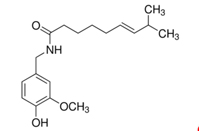|
Capsaicin is the main capsaicinoid in chili peppers.Capsaicin is known to stimulate sensory nerves leading to the activation of nociceptive and protective reflex responses (e.g., cough, bronchospasm) and the release of neurotransmitters from both peripheral and central nerve endings.
Application:
Food: Because of the burning sensation caused by capsaicin when it comes in contact with mucous membranes, it is commonly used in food products to give them added spice. In high concentrations, capsaicin will also cause a burning effect on other sensitive areas of skin. The degree of heat found within a food is often measured on the Scoville scale. In some cases, people enjoy the heat; there has long been a demand for capsaicin-spiced food and beverages. There are many cuisines and food products featuring capsaicin such as hot sauce, salsa, and beverages.
Pharmaceutical: Capsaicin is used as an analgesic in topical ointments, nasal sprays (Sinol-M), and dermal patches to relieve pain, typically in concentrations between 0.025% and 0.25%. It may be applied in cream form for the temporary relief of minor aches and pains of muscles and joints associated with arthritis, backache, strains and sprains, often in compounds with other rubefacients. It is also used to reduce the symptoms of peripheral neuropathy such as post-herpetic neuralgia caused by shingles. From some animal experiments, it shows capsaicin is a good candidate for anti-cancer drugs, becuase of its strong oxidizing property. Especially, capsaicin shown to suppress the growth of pancreatic cancer[1].
Applications of the high-concentration capsaicin patch over 1 year demonstrated its long-term safety with no increased incidence or severity of adverse events and no impact on neurologic function. The high-concentration capsaicin patch was well tolerated and the most common adverse events were application site-related, mild to moderate, and transient.
Topically applied capsaicin is useful in alleviating pain associated with diabetic neuropathy and chronic musculoskeletal pain. It is used to increase the bladder capacity and reduce incontinence in patients with bladder hyperactivity. Capsaicin can reduce post-operative nausea and vomiting when applied at acupressure points. It may be used to treat pruritis associated with renal failure and protect the stomach against non-steroidal anti-inflammatory drug induced gastritis. The development of capsaicin analogues and TRPV1 antagonists may provide more effective and better tolerated therapeutic agents in the future. Synthetic agents that are less pungent and target the TRPV1 receptor may prove to be more efficacious and more tolerable than naturally occurring capsaicin for the treatment of pain and inflammatory disease states.[3]
|
